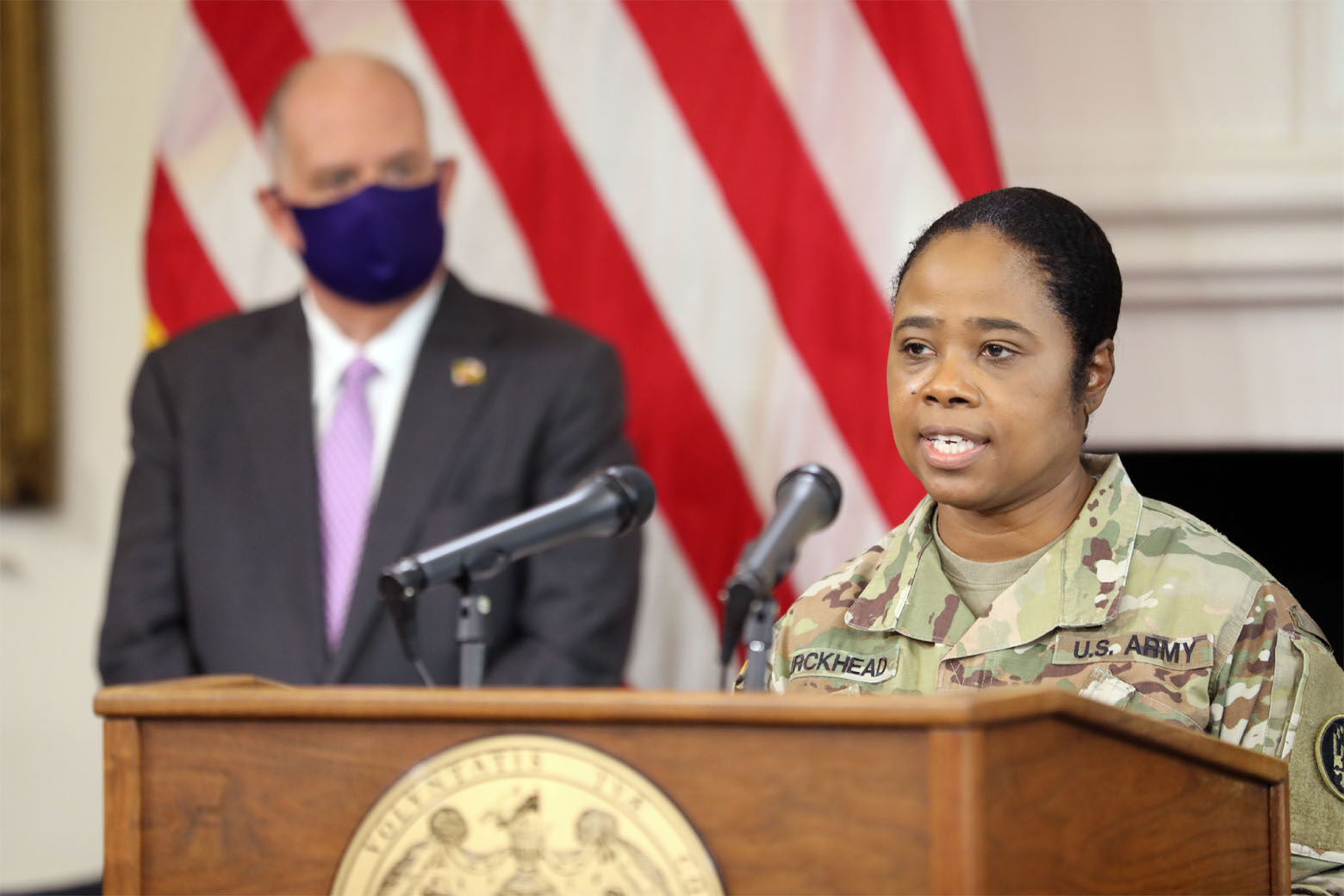
The head of the Maryland National Guard who’s leading a COVID-19 vaccine equity task force detailed an action plan Thursday for getting shots into the arms of hard-to-reach groups by partnering with churches and other community groups to quickly launch pop-up clinics.
“We want to meet people where they,” said Brig. Gen. Janeen Birckhead during a news conference Thursday with Maryland Gov. Larry Hogan.
Hogan billed it as a first-in-the-nation “vaccine equity operations plan” to address glaring racial gaps and inequities that have plagued the vaccine rollout in Maryland — and across the U.S.
The seven-step plan relies on community organizations proposing their locations to the equity task force, which will then vet proposals, perform site walk-throughs if necessary and then recruit hospitals and pharmacies to provide vaccine doses to the organizations to run their clinics.
The task force will also assist with the rollout, with a goal of providing enough support and oversight to make sure the clinic is self-sufficient going forward.
“The bottom line is that our efforts are transparent and will achieve what the governor has asked me to do, which is to break down barriers to expand access of the COVID-19 vaccine and to save lives of underserved, vulnerable and hard-to-reach communities,” Birckhead said.
An upcoming clinic at the First Baptist Church of Glenarden, a megachurch in Prince George’s County with a congregation of more than 10,000 worshippers, is expected to administer 900 shots a day when it opens on March 16. Vaccine doses will come from a stockpile allocated to the University of Maryland Medical System.
Such community clinics have already been piloted in smaller settings. A recent “soft launch” at New Shiloh Baptist Church in Baltimore has administered 50 doses with supplies that Safeway provided. On Saturday, a bigger event is planned — 250 vaccinations.
Lt. Gov. Boyd Rutherford said the goal of the action plan and its community clinics is to reach people “in ways that government often isn’t able to do.”
While much of the focus on expanding access to vaccines has centered on standing up mass vaccination sites across the state, Birckhead said, in addition to reaching targeting populations, this approach has the benefit of speed, since launching a mass vaccination site can take weeks of preparation and logistics.
Organizations interested in hosting clinics should contact their local health departments, Birckhead said. The state will also launch an online portal.
The equity plan will consider a host of factors to “identify the communities and the individuals who are vulnerable, underserved, hesitant or difficult to reach,” Birckhead said.
The factors include the population over 65; population with an annual income below $49,000; the unemployment rate; the population older than 25 without a high school diploma; minority composition of a community, the number of single-parent households, households with more than one person in a room, households without access to a car; total COVID cases; and the amount of the population that has already received at least a first dose of the vaccine.
Hogan defended his administration’s efforts to ensure COVID-19 vaccines are distributed equitably, saying, “From Day One, Maryland has made equitable access to vaccines a top priority.”
- Sign up for WTOP alerts
- Latest coronavirus test results in DC, Maryland and Virginia
- Coronavirus vaccine FAQ: What you need to know
- Latest vaccination numbers in DC, Maryland and Virginia
Looking for more information? D.C., Maryland and Virginia are each releasing more data every day. Visit their official sites here: Virginia | Maryland | D.C.
Still, some local officials have sharply criticized the state’s equity plans.
In Montgomery County, all nine members of the Montgomery County Council sent a letter to Hogan’s administration, writing, “Communities of color must be a priority when it comes to receiving the COVID-19 vaccine and we now know that it is also imperative that younger members of those communities get vaccinated sooner.”
The letter noted the disparities in life expectancy for Black and Latino people compared to white people.
The letter also called for stricter accountability for retail pharmacies to ensure vaccines are distributed equitably.
“Recently, the Council received a report of one retail outlet pulling vaccines from a location that served a more vulnerable population and giving them to another outlet in a more affluent area,” the letter stated. “It is clear that our vaccine registration systems must immediately be revised to include a prioritization based on race and ethnicity.”
A directive from the Maryland Department of Health calls on pharmacy vaccine providers to prioritize 50% of their doses to “vulnerable” populations.
In Prince George’s County, where residents have been boxed out of appointments at the Six Flags mass-vaccination site, County Executive Angela Alsobrooks said there’s been too much talk of hesitancy about getting the vaccine.
“This phrase has been used a lot lately and, and I’ve heard many concerns from our residents.” Alsobrooks said during a news conference Thursday. “That’s because, unfortunately, the narrative has become that Black and brown people are being vaccinated at lower rates because they don’t want the vaccine … The main issue right now, however, is actually lack of access to vaccinations. It is not the hesitancy.”








